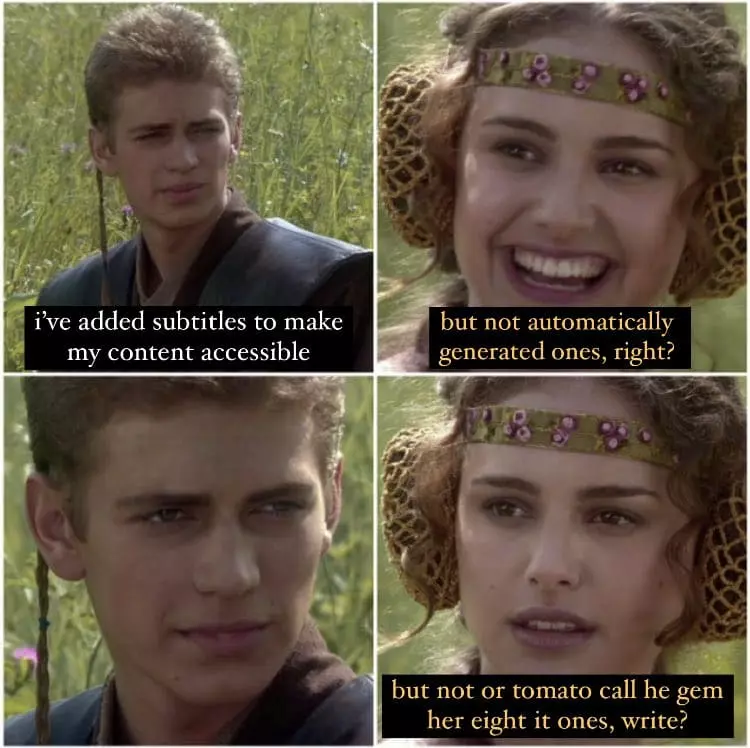
自动字幕技术如何运作?
In the digital age, autocaptioning has become an integral part of video content. It not only enhances viewers’ comprehension experience but is also crucial for accessibility and international dissemination.
Yet a core question remains: “How Accurate is Autocaptioning?” The accuracy of captions directly impacts the credibility of information and the effectiveness of its dissemination. This article will explore the true performance of autocaptioning by examining the latest speech recognition technologies, comparative data across different platforms, and user experiences. We will also share Easysub’s professional expertise in enhancing caption quality.
To understand “How Accurate is Autocaptioning?”, one must first grasp how automatic captions are generated. At its core, autocaptioning relies on Automatic Speech Recognition (ASR) technology, which uses artificial intelligence and natural language processing models to convert spoken content into text.
As a brand specializing in subtitle generation and optimization, 易订阅 integrates deep learning and post-processing mechanisms in practical applications to reduce errors to a certain extent, providing users with higher-quality subtitle solutions.
When discussing “How Accurate is Autocaptioning?”, we need a scientific set of measurement standards. The accuracy of captions is not merely about “how close they appear to be,” but rather involves clear evaluation methods and metrics.
This is the most commonly used metric, calculated as follows:
WER = (Replacement count + Deletion count + Insertion count)/Total word count
例如
Here, replacing “love” with “喜欢” constitutes an incorrect substitution.
Measured at the sentence level, where any error in a subtitle counts as an entire sentence error. This stricter standard is commonly used in professional contexts (e.g., legal or medical subtitling).
Particularly suitable for evaluating accuracy in non-phonetic languages such as Chinese and Japanese. Its calculation method is similar to WER, but uses “characters” as the basic unit.
例如
Although the WER indicates an error, viewers can still grasp the meaning, so “comprehensibility” remains high in this case.
Within the industry, a 95% WER accuracy rate is considered relatively high. However, for scenarios such as legal, educational, and professional media contexts, an accuracy rate approaching 99% is often required to meet demands.
By comparison, common platforms like YouTube’s automatic captions achieve accuracy rates between 60% and 90%, depending on audio quality and speaking conditions. Professional tools like 易订阅, however, combine AI optimization with post-editing after automatic recognition, significantly reducing error rates.
When addressing the question “How Accurate is Autocaptioning?”, the accuracy of captions is influenced by multiple external factors beyond the technology itself. Even the most advanced AI speech recognition models exhibit significant variations in performance across different environments. The primary influencing factors are as follows:
Platform-embedded subtitles (e.g., YouTube, Zoom, TikTok) typically rely on universal models suitable for everyday use, but their accuracy remains inconsistent.
Professional subtitling tools (e.g., 易订阅) combine post-processing optimization with human proofreading after recognition, delivering higher accuracy in noisy environments and complex contexts.
| Platform/Tool | 精度范围 | 优势 | 限制 |
|---|---|---|---|
| YouTube | 60% – 90% | Wide coverage, multilingual support, good for creators | High error rate with accents, noise, or technical terms |
| Zoom/Google Meet | 70% – 85% | Real-time captions, suitable for education and meetings | Errors in multi-speaker or multilingual scenarios |
| Microsoft Teams | 75% – 88% | Integrated into workplace, supports live transcription | Weaker performance in non-English, struggles with jargon |
| TikTok / Instagram | 65% – 80% | Fast auto-generation, ideal for short videos | Prioritizes speed over accuracy, frequent typos/misrecognitions |
| Easysub (Pro Tool) | 90% – 98% | AI + post-editing, strong for multilingual & technical content, high accuracy | May require investment compared to free platforms |
Although the accuracy of automatic captions has improved significantly in recent years, achieving higher-quality captions in practical use requires optimization across multiple aspects:
Automatic subtitles are rapidly evolving toward greater accuracy, intelligence, and personalization. With advances in deep learning and large language models (LLMs), systems will achieve more stable recognition across accents, lesser-known languages, and noisy environments. They will also automatically correct homophones, identify specialized terminology, and recognize industry-specific vocabulary based on contextual understanding. Simultaneously, tools will better understand users: distinguishing speakers, highlighting key points, adjusting display for reading habits, and providing real-time multilingual subtitles for both live streams and on-demand content. Deep integration with editing software and live streaming/platforms will also enable a nearly seamless “generation-proofing-publishing” workflow.
Along this evolutionary path, 易订阅 positions itself to integrate “free trial + professional upgrade” into a complete workflow: higher recognition accuracy, multilingual translation, standard format export, and team collaboration. Continuously incorporating the latest AI capabilities, it serves the global communication needs of creators, educators, and enterprises. In short, the future of automatic subtitling is not just about being “more accurate,” but about being “more attuned to you”—evolving from an auxiliary tool into the foundational infrastructure of intelligent communication.
在内容全球化和短视频爆炸式增长的时代,自动字幕已成为提高视频可见性、可访问性和专业性的关键工具。.
有了像 易订阅, ,内容创作者和企业可以在更短的时间内制作出高质量、多语言、准确同步的视频字幕,大大提高观看体验和分发效率。.
在内容全球化和短视频爆炸式增长的时代,自动字幕制作已成为提升视频可见度、可访问性和专业度的关键工具。借助 Easysub 等 AI 字幕生成平台,内容创作者和企业能够在更短的时间内制作出高质量、多语言、精准同步的视频字幕,从而显著提升观看体验和分发效率。.
无论您是新手还是经验丰富的创作者,Easysub 都能加速并增强您的内容创作。立即免费试用 Easysub,体验 AI 字幕的高效智能,让每个视频都能跨越语言界限,触达全球受众!
只需几分钟,即可让 AI 为您的内容赋能!
👉 点击此处免费试用: easyssub.com
感谢您阅读本博客。. 如有更多问题或定制需求,请随时联系我们!
